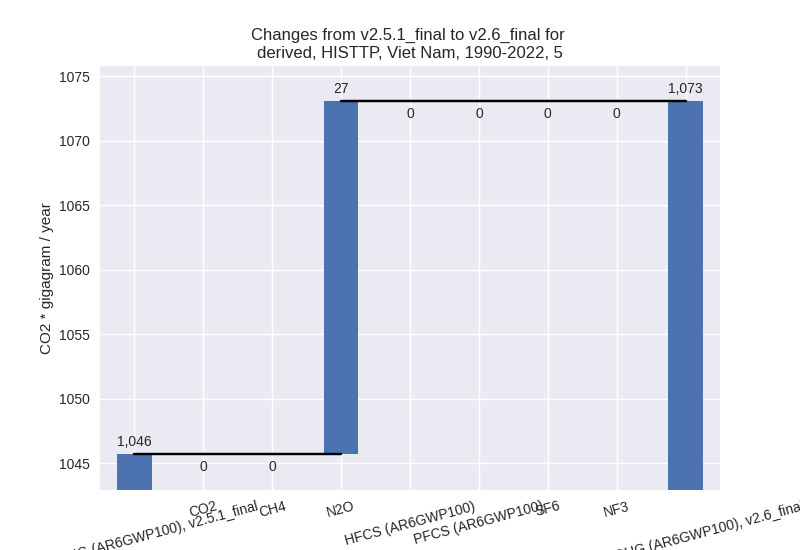Changes in PRIMAP-hist v2.6_final compared to v2.5.1_final for Viet Nam
2024-09-24
Johannes Gütschow
Change analysis for Viet Nam for PRIMAP-hist v2.6_final compared to v2.5.1_final
Overview over emissions by sector and gas
The following figures show the aggregate national total emissions excluding LULUCF AR6GWP100 for the country reported priority scenario. The dotted linesshow the v2.5.1_final data.

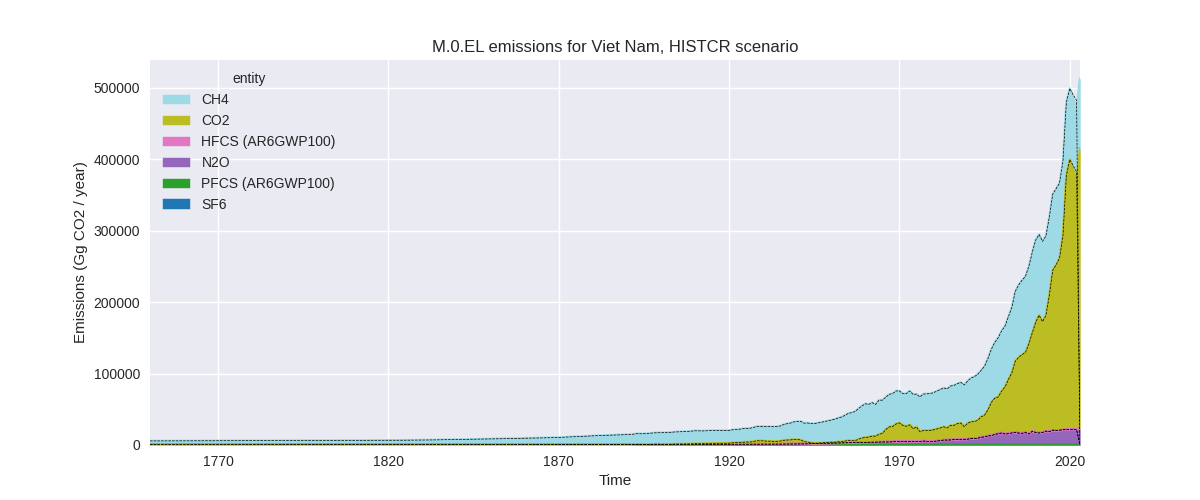
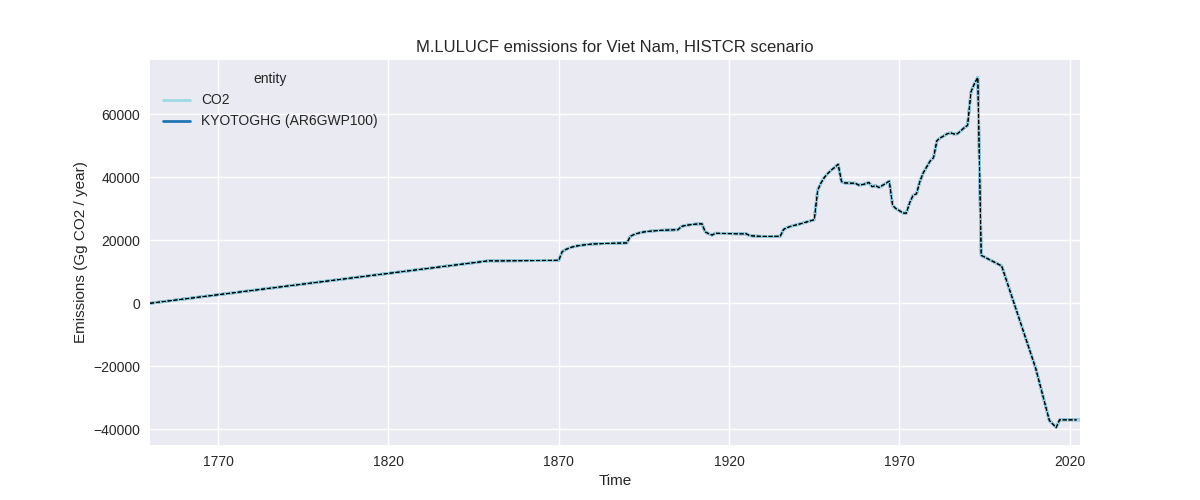
The following figures show the aggregate national total emissions excluding LULUCF AR6GWP100 for the third party priority scenario. The dotted linesshow the v2.5.1_final data.
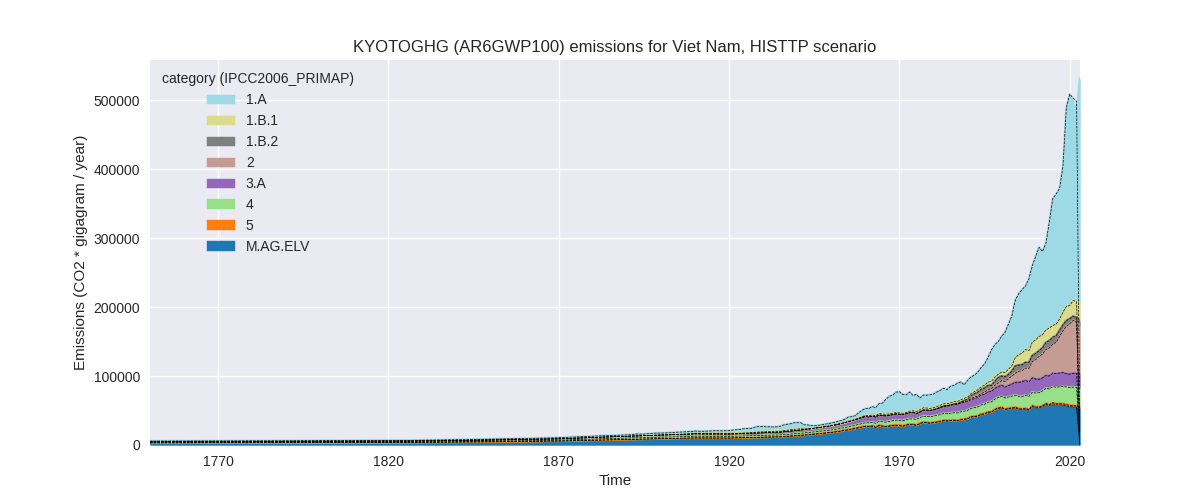
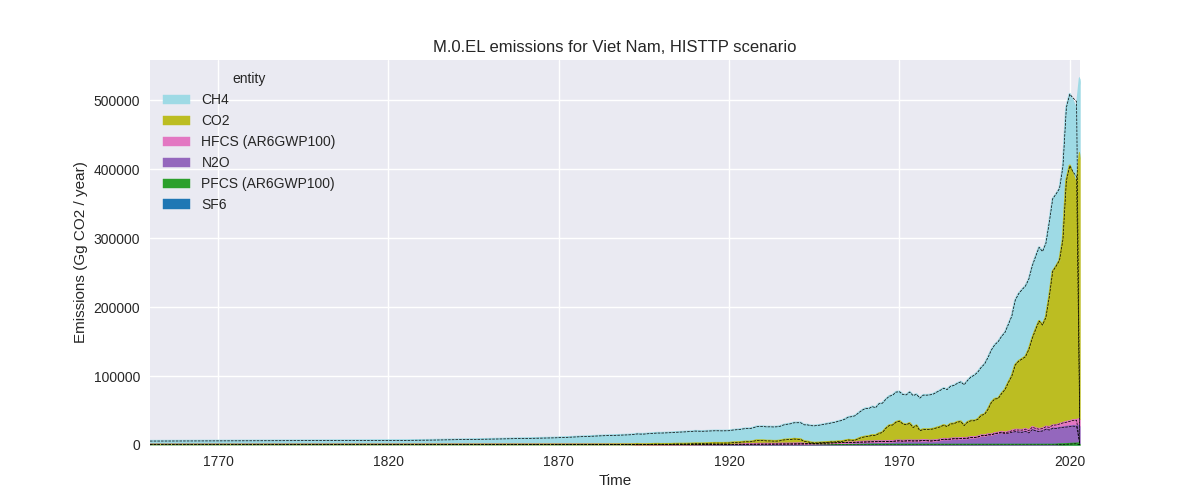
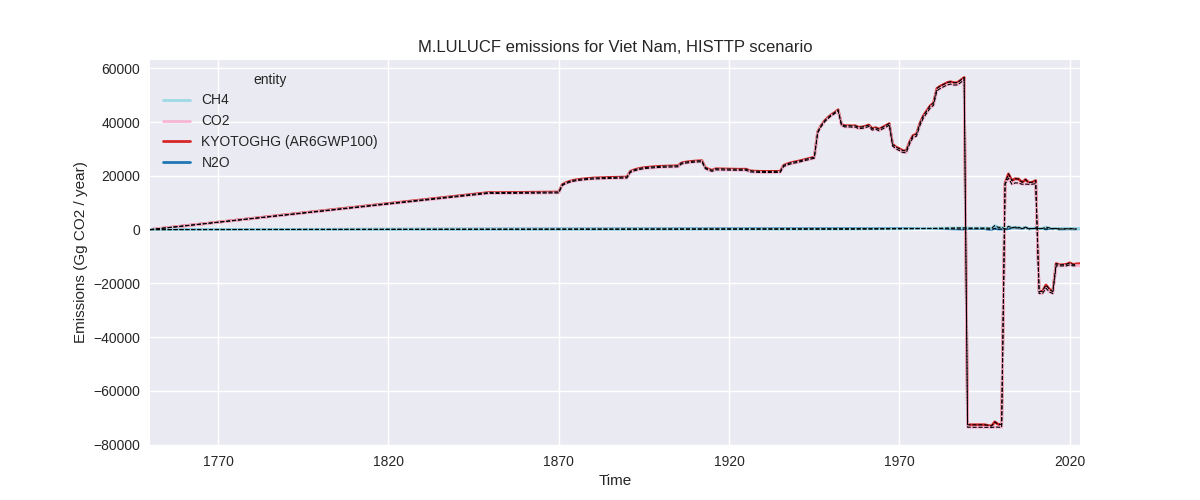
Overview over changes
In the country reported priority scenario we have the following changes for aggregate Kyoto GHG and national total emissions excluding LULUCF (M.0.EL):
- Emissions in 2022 have changed by -2.7%% (-12832.25 Gg CO2 / year)
- Emissions in 1990-2022 have changed by -0.2%% (-550.70 Gg CO2 / year)
In the third party priority scenario we have the following changes for aggregate Kyoto GHG and national total emissions excluding LULUCF (M.0.EL):
- Emissions in 2022 have changed by -2.6%% (-13147.49 Gg CO2 / year)
- Emissions in 1990-2022 have changed by -0.2%% (-598.12 Gg CO2 / year)
Most important changes per scenario and time frame
In the country reported priority scenario the following sector-gas combinations have the highest absolute impact on national total KyotoGHG (AR6GWP100) emissions in 2022 (top 5):
- 1: 1.A, CO2 with -13140.71 Gg CO2 / year (-4.7%)
- 2: 2, CO2 with 200.03 Gg CO2 / year (0.3%)
- 3: 5, N2O with 161.85 Gg CO2 / year (9.0%)
- 4: 4, CO2 with -82.84 Gg CO2 / year (-8.0%)
- 5: 2, N2O with 39.97 Gg CO2 / year (315.4%)
In the country reported priority scenario the following sector-gas combinations have the highest absolute impact on national total KyotoGHG (AR6GWP100) emissions in 1990-2022 (top 5):
- 1: 1.A, CO2 with -556.22 Gg CO2 / year (-0.5%)
- 2: 1.B.2, CO2 with -34.55 Gg CO2 / year (-2.6%)
- 3: 5, N2O with 27.36 Gg CO2 / year (2.6%)
- 4: 4, CO2 with -8.11 Gg CO2 / year (-1.3%)
- 5: 2, CO2 with 6.06 Gg CO2 / year (0.0%)
In the third party priority scenario the following sector-gas combinations have the highest absolute impact on national total KyotoGHG (AR6GWP100) emissions in 2022 (top 5):
- 1: 1.A, CO2 with -13445.17 Gg CO2 / year (-4.7%)
- 2: 2, CO2 with 180.00 Gg CO2 / year (0.3%)
- 3: 5, N2O with 161.85 Gg CO2 / year (9.0%)
- 4: 2, HFCS (AR6GWP100) with 131.92 Gg CO2 / year (1.5%)
- 5: 4, N2O with -112.36 Gg CO2 / year (-6.7%)
In the third party priority scenario the following sector-gas combinations have the highest absolute impact on national total KyotoGHG (AR6GWP100) emissions in 1990-2022 (top 5):
- 1: 1.A, CO2 with -569.10 Gg CO2 / year (-0.5%)
- 2: 4, CH4 with -58.06 Gg CO2 / year (-0.3%)
- 3: 5, N2O with 27.36 Gg CO2 / year (2.6%)
- 4: 4, N2O with -10.20 Gg CO2 / year (-1.0%)
- 5: 2, CO2 with 5.45 Gg CO2 / year (0.0%)
Notes on data changes
Here we list notes explaining important emissions changes for the country. ’' means that the following text only applies to the TP time series, while means that it only applies to the CR scenario. Otherwise the note applies to both scenarios.
- Changes in energy, flaring and cement CO2 are due to updated third party data. Changes in TP and CR time series are very similar.
- Changes in sectors 4 and 5 are due to the removal of FAOSTAT data.
- The high change in post-2016 N2O emission from chemical industry (2.B) comes from the shorter extrapolation trend period.
Changes by sector and gas
For each scenario and time frame the changes are displayed for all individual sectors and all individual gases. In the sector plot we use aggregate Kyoto GHGs in AR6GWP100. In the gas plot we usenational total emissions without LULUCF. ## country reported scenario
2022
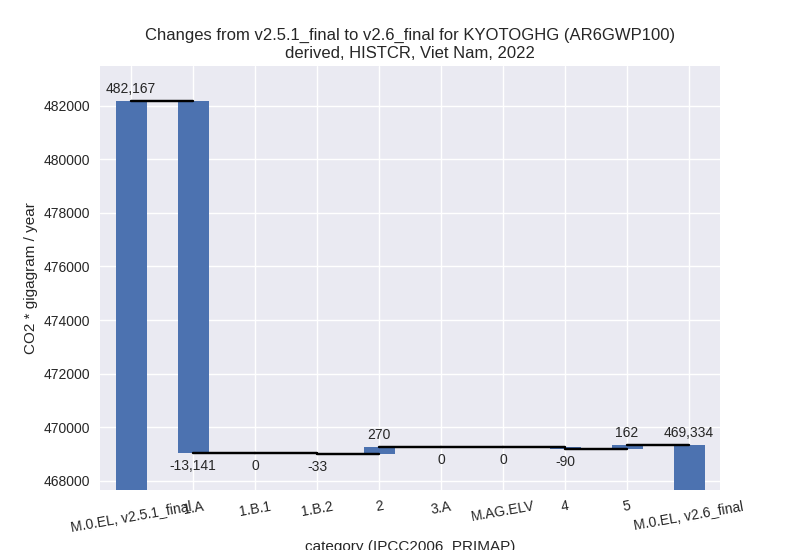
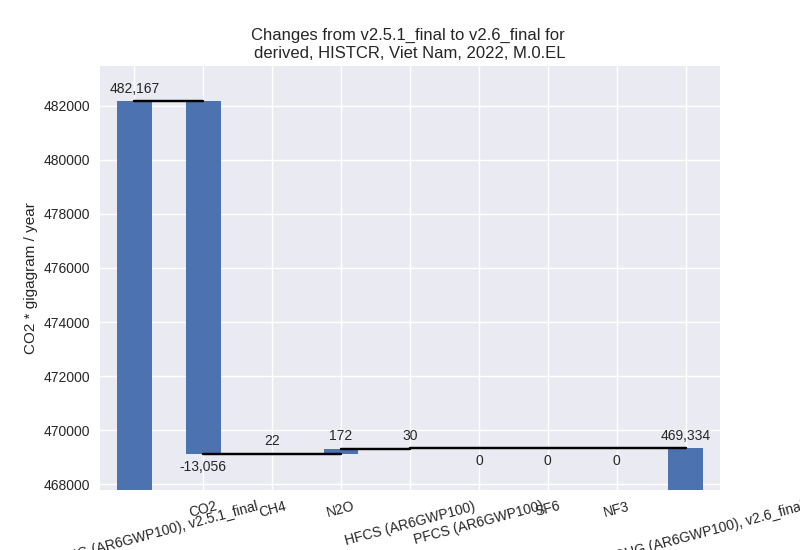
1990-2022
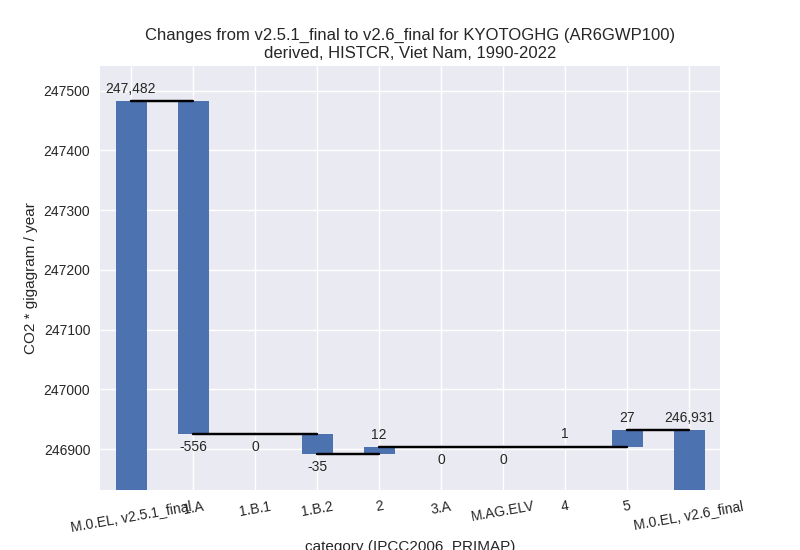
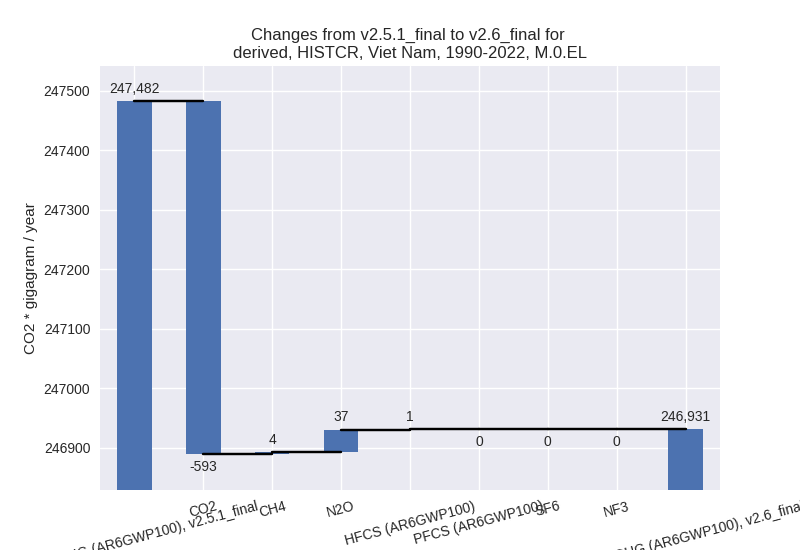
third party scenario
2022

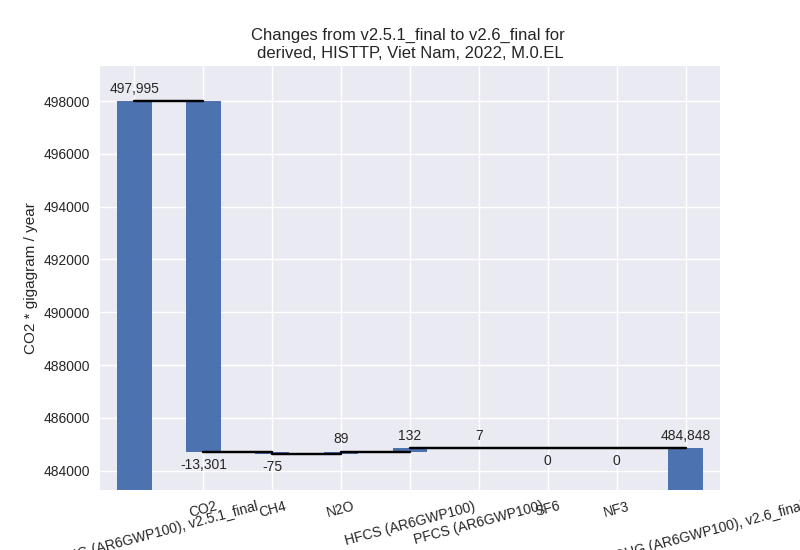
1990-2022
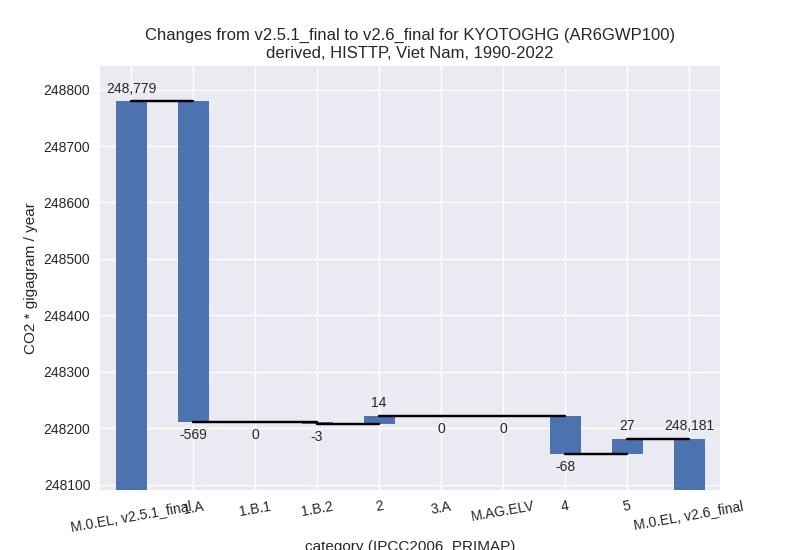
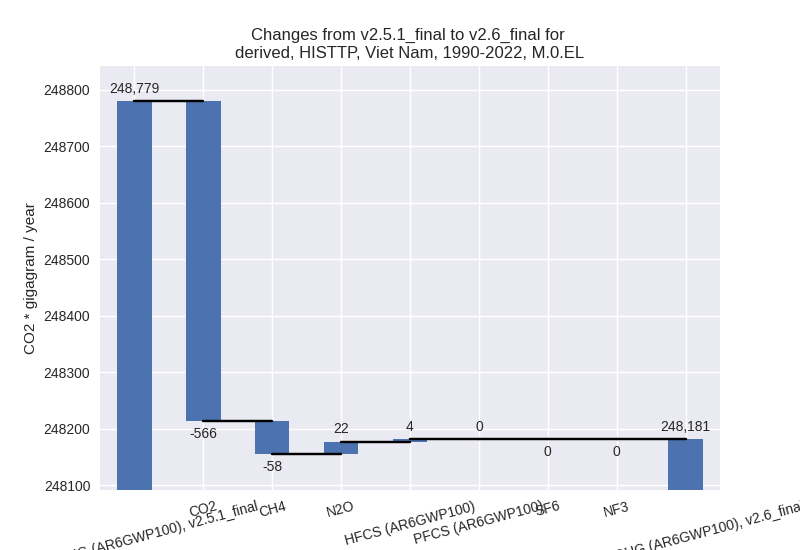
Detailed changes for the scenarios:
country reported scenario (HISTCR):
Most important changes per time frame
For 2022 the following sector-gas combinations have the highest absolute impact on national total KyotoGHG (AR6GWP100) emissions in 2022 (top 5):
- 1: 1.A, CO2 with -13140.71 Gg CO2 / year (-4.7%)
- 2: 2, CO2 with 200.03 Gg CO2 / year (0.3%)
- 3: 5, N2O with 161.85 Gg CO2 / year (9.0%)
- 4: 4, CO2 with -82.84 Gg CO2 / year (-8.0%)
- 5: 2, N2O with 39.97 Gg CO2 / year (315.4%)
For 1990-2022 the following sector-gas combinations have the highest absolute impact on national total KyotoGHG (AR6GWP100) emissions in 1990-2022 (top 5):
- 1: 1.A, CO2 with -556.22 Gg CO2 / year (-0.5%)
- 2: 1.B.2, CO2 with -34.55 Gg CO2 / year (-2.6%)
- 3: 5, N2O with 27.36 Gg CO2 / year (2.6%)
- 4: 4, CO2 with -8.11 Gg CO2 / year (-1.3%)
- 5: 2, CO2 with 6.06 Gg CO2 / year (0.0%)
Changes in the main sectors for aggregate KyotoGHG (AR6GWP100) are
- 1: Total sectoral emissions in 2022 are 286638.30
Gg CO2 / year which is 61.1% of M.0.EL emissions. 2022 Emissions have
changed by -4.4% (-13173.53 Gg CO2 /
year). 1990-2022 Emissions have changed by -0.5% (-590.76 Gg CO2 / year). For 2022
the changes per gas
are:

The changes come from the following subsectors:- 1.A: Total sectoral emissions in 2022 are 269097.89
Gg CO2 / year which is 93.9% of category 1 emissions. 2022 Emissions
have changed by -4.7% (-13140.70 Gg
CO2 / year). 1990-2022 Emissions have changed by -0.5% (-556.22 Gg CO2 / year). For 2022
the changes per gas
are:
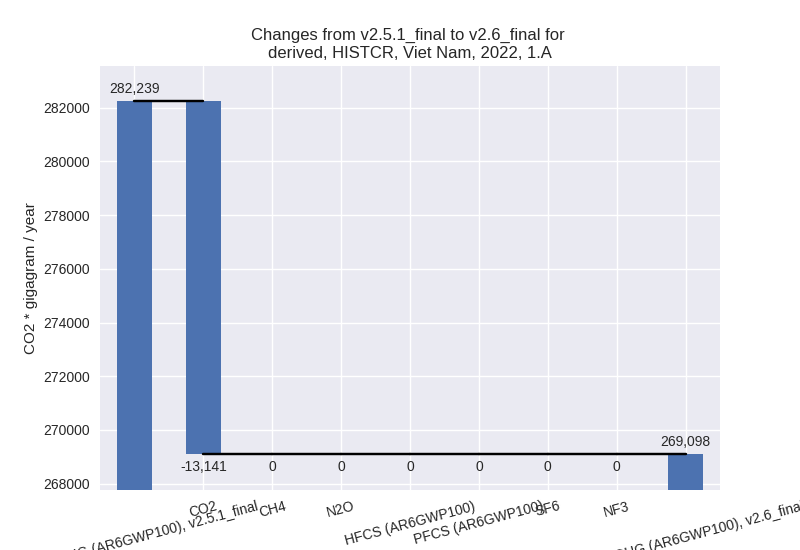
There is no subsector information available in PRIMAP-hist. - 1.B.1: Total sectoral emissions in 2022 are 4943.45 Gg CO2 / year which is 1.7% of category 1 emissions. 2022 Emissions have changed by 0.0% (0.00 Gg CO2 / year). 1990-2022 Emissions have changed by 0.0% (0.00 Gg CO2 / year).
- 1.B.2: Total sectoral emissions in 2022 are 12596.96 Gg CO2 / year which is 4.4% of category 1 emissions. 2022 Emissions have changed by -0.3% (-32.84 Gg CO2 / year). 1990-2022 Emissions have changed by -0.3% (-34.55 Gg CO2 / year).
- 1.A: Total sectoral emissions in 2022 are 269097.89
Gg CO2 / year which is 93.9% of category 1 emissions. 2022 Emissions
have changed by -4.7% (-13140.70 Gg
CO2 / year). 1990-2022 Emissions have changed by -0.5% (-556.22 Gg CO2 / year). For 2022
the changes per gas
are:
- 2: Total sectoral emissions in 2022 are 77086.21 Gg CO2 / year which is 16.4% of M.0.EL emissions. 2022 Emissions have changed by 0.4% (269.57 Gg CO2 / year). 1990-2022 Emissions have changed by 0.0% (11.98 Gg CO2 / year).
- M.AG: Total sectoral emissions in 2022 are 80038.21 Gg CO2 / year which is 17.1% of M.0.EL emissions. 2022 Emissions have changed by 0.0% (0.00 Gg CO2 / year). 1990-2022 Emissions have changed by 0.0% (0.00 Gg CO2 / year).
- 4: Total sectoral emissions in 2022 are 23606.95 Gg CO2 / year which is 5.0% of M.0.EL emissions. 2022 Emissions have changed by -0.4% (-90.13 Gg CO2 / year). 1990-2022 Emissions have changed by 0.0% (0.72 Gg CO2 / year).
- 5: Total sectoral emissions in 2022 are 1964.63 Gg
CO2 / year which is 0.4% of M.0.EL emissions. 2022 Emissions have
changed by 9.0% (161.85 Gg CO2 /
year). 1990-2022 Emissions have changed by 2.6% (27.36 Gg CO2 / year). For 2022 the
changes per gas
are:
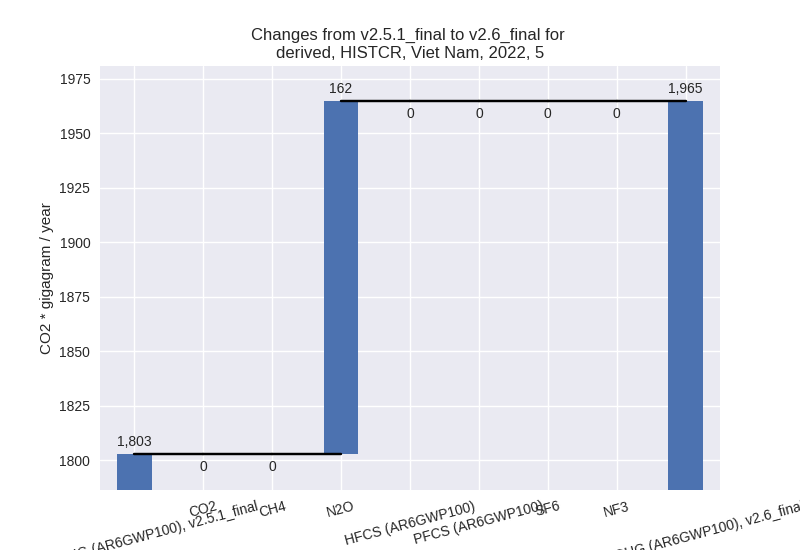
For 1990-2022 the changes per gas are: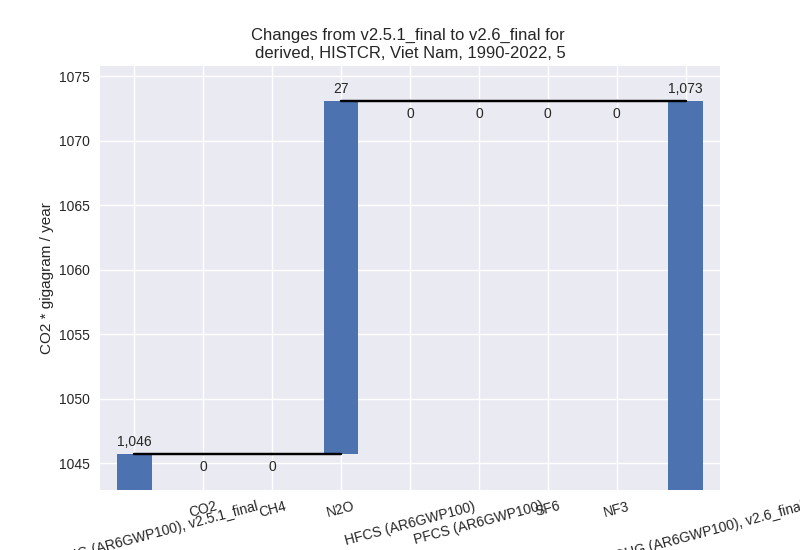
third party scenario (HISTTP):
Most important changes per time frame
For 2022 the following sector-gas combinations have the highest absolute impact on national total KyotoGHG (AR6GWP100) emissions in 2022 (top 5):
- 1: 1.A, CO2 with -13445.17 Gg CO2 / year (-4.7%)
- 2: 2, CO2 with 180.00 Gg CO2 / year (0.3%)
- 3: 5, N2O with 161.85 Gg CO2 / year (9.0%)
- 4: 2, HFCS (AR6GWP100) with 131.92 Gg CO2 / year (1.5%)
- 5: 4, N2O with -112.36 Gg CO2 / year (-6.7%)
For 1990-2022 the following sector-gas combinations have the highest absolute impact on national total KyotoGHG (AR6GWP100) emissions in 1990-2022 (top 5):
- 1: 1.A, CO2 with -569.10 Gg CO2 / year (-0.5%)
- 2: 4, CH4 with -58.06 Gg CO2 / year (-0.3%)
- 3: 5, N2O with 27.36 Gg CO2 / year (2.6%)
- 4: 4, N2O with -10.20 Gg CO2 / year (-1.0%)
- 5: 2, CO2 with 5.45 Gg CO2 / year (0.0%)
Changes in the main sectors for aggregate KyotoGHG (AR6GWP100) are
- 1: Total sectoral emissions in 2022 are 306752.14
Gg CO2 / year which is 63.3% of M.0.EL emissions. 2022 Emissions have
changed by -4.2% (-13476.63 Gg CO2 /
year). 1990-2022 Emissions have changed by -0.4% (-572.07 Gg CO2 / year). For 2022
the changes per gas
are:
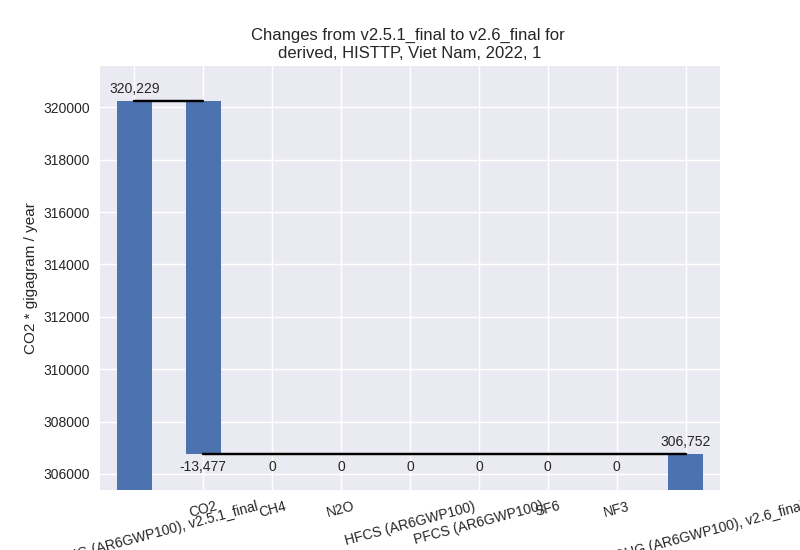
The changes come from the following subsectors:- 1.A: Total sectoral emissions in 2022 are 276756.68
Gg CO2 / year which is 90.2% of category 1 emissions. 2022 Emissions
have changed by -4.6% (-13445.17 Gg
CO2 / year). 1990-2022 Emissions have changed by -0.5% (-569.10 Gg CO2 / year). For 2022
the changes per gas
are:
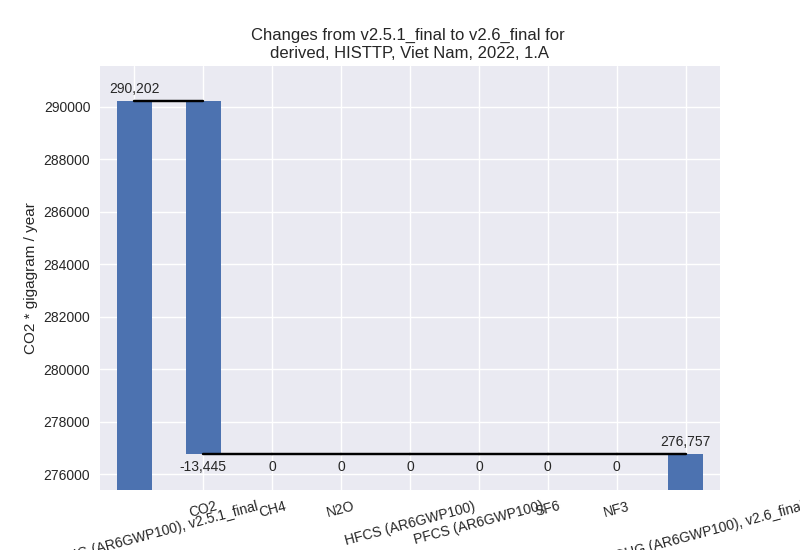
There is no subsector information available in PRIMAP-hist. - 1.B.1: Total sectoral emissions in 2022 are 23752.25 Gg CO2 / year which is 7.7% of category 1 emissions. 2022 Emissions have changed by 0.0% (0.00 Gg CO2 / year). 1990-2022 Emissions have changed by 0.0% (0.00 Gg CO2 / year).
- 1.B.2: Total sectoral emissions in 2022 are 6243.20 Gg CO2 / year which is 2.0% of category 1 emissions. 2022 Emissions have changed by -0.5% (-31.47 Gg CO2 / year). 1990-2022 Emissions have changed by -0.0% (-2.97 Gg CO2 / year).
- 1.A: Total sectoral emissions in 2022 are 276756.68
Gg CO2 / year which is 90.2% of category 1 emissions. 2022 Emissions
have changed by -4.6% (-13445.17 Gg
CO2 / year). 1990-2022 Emissions have changed by -0.5% (-569.10 Gg CO2 / year). For 2022
the changes per gas
are:
- 2: Total sectoral emissions in 2022 are 74386.99 Gg CO2 / year which is 15.3% of M.0.EL emissions. 2022 Emissions have changed by 0.5% (358.70 Gg CO2 / year). 1990-2022 Emissions have changed by 0.1% (14.45 Gg CO2 / year).
- M.AG: Total sectoral emissions in 2022 are 74785.90 Gg CO2 / year which is 15.4% of M.0.EL emissions. 2022 Emissions have changed by 0.0% (0.00 Gg CO2 / year). 1990-2022 Emissions have changed by 0.0% (0.00 Gg CO2 / year).
- 4: Total sectoral emissions in 2022 are 26957.96 Gg CO2 / year which is 5.6% of M.0.EL emissions. 2022 Emissions have changed by -0.7% (-191.40 Gg CO2 / year). 1990-2022 Emissions have changed by -0.4% (-67.86 Gg CO2 / year).
- 5: Total sectoral emissions in 2022 are 1964.63 Gg
CO2 / year which is 0.4% of M.0.EL emissions. 2022 Emissions have
changed by 9.0% (161.85 Gg CO2 /
year). 1990-2022 Emissions have changed by 2.6% (27.36 Gg CO2 / year). For 2022 the
changes per gas
are:
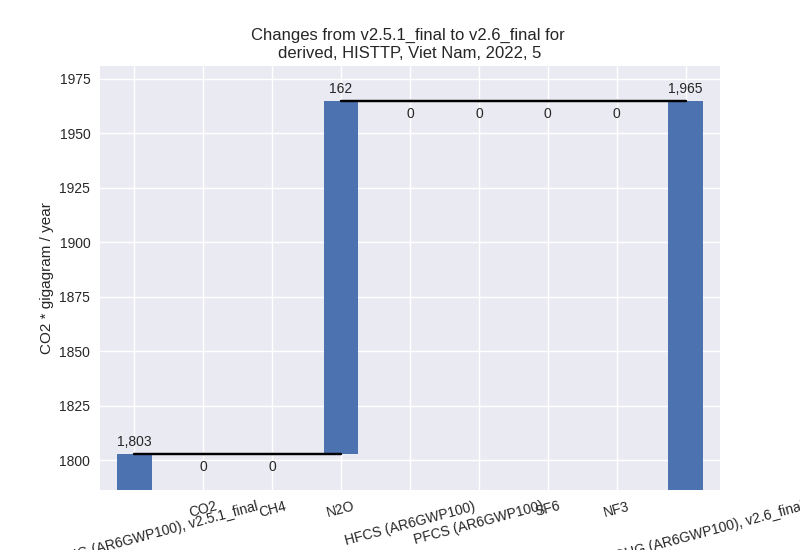
For 1990-2022 the changes per gas are: